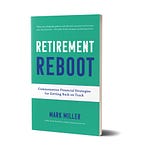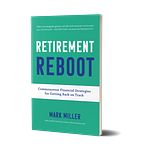This week on the podcast, we consider the sorry state of affairs in the world of long-term care.
The U.S. has never had good answers when it comes to insuring against the risk of a long-term care need. And now, the pandemic is raising the stakes. Costs are rising for everything from assisted living to skilled nursing facilities and home-based care. Meanwhile, the pandemic has taken the lives of more than 100,000 residents and staff of long-term care facilities.
Where will this leave us after the pandemic recedes? Joining me is the leader of one of the country’s most important senior advocacy organizations - Max Richtman. Max is the CEO of the National Committee to Preserve Social Security and Medicare, an organization that works on a range of issues related to financial security and health.
Max recently wrote an op-ed for The Hill on one aspect of the long-term care crisis - that is, his view that we need a federally-sponsored long-term care insurance program. I invited Max to join me on the podcast to talk that idea through, and how the debate on this topic is shaping up in Washington.
Click the player icon at the top of the page to listen to the podcast, which also can be found on Apple Podcasts, Spotify and Stitcher.
Requesting your feedback on the newsletter
Thank you for reading the RetirementRevised.com newsletter - I hope you are finding it useful.
I'm considering possible new directions for the newsletter in 2021, and I would really appreciate your feedback. I’d like to learn a bit about what you value in the current newsletter, and what would make it more valuable to you.
Please take a few minutes to complete this survey - it won’t take more than a couple minutes, I promise!
The “shecession” will widen the already-wide gender gap in retirement security
Much has been written about the “shecession” this year - the fact that women have faced disproportionate job loss due to the unique impact of the pandemic on the economy. Industries where women tend to work have been hit hardest - education, health care and social services and service industries such as hairdressers, dry cleaners, dental offices and clothing stores. At the same time, women have born the brunt of increased caregiving responsibilities for children and elderly parents. Some of that reflects gender bias no doubt - but it also points to a vicious circle of sorts. Since women earn less, two-income households are deciding that the higher-earner should keep working when it becomes necessary for one to stay home. That’s just rational economic decision-making.
Less appreciated is the way the shecession will impact retirement down the road for women now in their prime working years. The chart above comes from a calculator developed by the Center for American Progress that allows you to run “what if” scenarios and illustrate the impact on lost wages, wage growth and retirement benefits over the longer arc of your working life.
One recent study by a trio of economists found a disproportionate decline in employment for women of prime working age (25 to 55) compared with men - and especially so for women who have children.
“My concern is that the ‘motherhood penalty’ is being exacerbated by the pandemic and could even unravel some of the progress women have made relative to men in the labor market over the past few decades,” says Robert Fairlie, a professor of economics at the University of California, Santa Cruz and a co-author of the study.
Jobless rates for women have spiked significantly since last fall, when the pandemic prevented most school districts from opening safely. Four times as many women as men dropped out of the labor force in September alone, according to CAP.
“A lot of women had been holding on until September, but when most schools only opened virtually, it became really crushing and too much to manage,” says Colleen Curtis, chief community officer at The Mom Project, a job marketplace that connects family-friendly employers with working mothers.
In my latest “Retiring” column for The New York Times, I look at the retirement risk facing women - and what can be done to mitigate it.
Single women are most at risk - a group that includes those who are widowed, divorced or never married. Federal data shows that older women are more likely to live alone than men - either because they are widowed, divorced or never married. The Elder Index, a data set from the University of Massachusetts Boston that aims to measure the capacity of older people to cover basic living expenses, shows that older women living alone have a 57 percent risk of economic insecurity, compared with 46 percent for men.
Solutions? Better support at the national level for caregiving would be very smart economic policy. That’s because it would make it so much easier for workers to balance careers with caregiving demands. Legislation promoting pay equity also is important, along with Social Security reforms that focus on boosting benefits for women also can play a critical role.
Some reforms to the retirement saving system also make sense - boosting the ceiling on catch-up contributions for late-career workers, for example. But these seem less important than the ones mentioned above.














